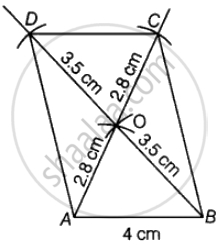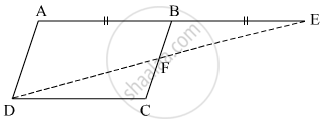Advertisements
Advertisements
प्रश्न
Construct a parallelogram when one of its side is 4 cm and its two diagonals are 5.6 cm and 7 cm. Measure the other side.
उत्तर

Steps of construction:
Step I: Draw AB = 4 cm.
Step II: With A as centre and radius 2.8 cm, draw an arc.
Step III: With B as centre and radius 3.5 cm, draw another arc cutting the previous arc at O.
Step IV: Join OA and OB.
Step V: Produce AO to C that is OC = AO and produce BO to D that is OD = BD.
Step VI: Join AD, BC and CD.
Hence, ABCD is the required parallelogram.
APPEARS IN
संबंधित प्रश्न
In the given figure, `square`ABCD is a parallelogram. Point E is on the ray AB such that BE = AB then prove that line ED bisects seg BC at point F.

In the given figure, G is the point of concurrence of medians of ΔDEF. Take point H on ray DG such that D-G-H and DG = GH, then prove that `square`GEHF is a parallelogram.

Ratio of two adjacent sides of a parallelogram is 3 : 4, and its perimeter is 112 cm. Find the length of its each side.
Construct a parallelogram ABCD such that l(BC) = 7 cm, m∠ABC = 40° , l(AB) = 3 cm.
In parallelogram ABCD, E is the mid-point of AD and F is the mid-point of BC. Prove that BFDE is a parallelogram.
Use the information given in the alongside diagram to find the value of x, y, and z.

If a triangle and a parallelogram lie on the same base and between the same parallels, then prove that the area of the triangle is equal to half of the area of parallelogram
If opposite angles of a quadrilateral are equal, it must be a parallelogram.
ABCD is a parallelogram. The bisector of angle A intersects CD at X and bisector of angle C intersects AB at Y. Is AXCY a parallelogram? Give reason.
A diagonal of a parallelogram bisects an angle. Will it also bisect the other angle? Give reason.
